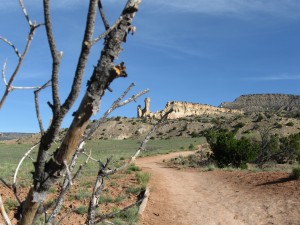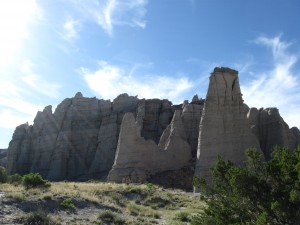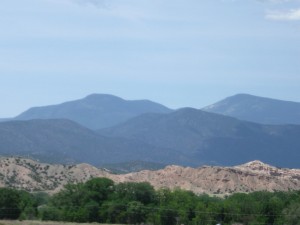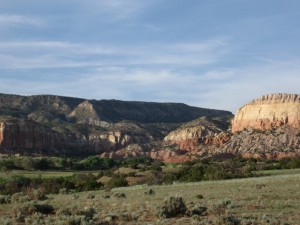
We started the day very early in an effort to capture the morning light, and to get out before the day’s incredible (uncharacteristic) heat set in. We walked a short way into the Chimney Rock hiking trail to shoot a stunning 360 degree vista. We spent the rest of the morning exploring other views in the area, and the part of Ghost Ranch known as the Piedra Lumbre basin, which includes the several acres of land that O’Keeffe actually owned. Unfortunately, we discovered that the hiking trails there are currently closed to visitors ”“ but we were able to enjoy the landscape from the side of the road, and caught a distant glimpse of O’Keeffe’s home and studio (owned and maintained by the museum, but closed to the public), where she painted views of Pedernal and the badlands that surrounded her.
After an afternoon of filming and walking, we left Ghost Ranch to check in at the Abiquiu Inn, where we will spend the next few days. The inn is a short drive away from Ghost Ranch and close to the town of Abiquiu, where O’Keeffe kept a home for the non-summer months.

Following our arrival at the inn, we promptly drove to the nearby “White Place”, an area which was the subject of several O’Keeffe paintings. Her paintings focus on isolated detail views, which highlight the shapes and negative space in the column-like rock formations (see “From the White Place”). I didn’t know quite what the White Place would be like in person.
It was breathtaking. Cliffs, columns and mushrooms of soft white rock roll off into the distance, giving the appearance of an ancient Roman palace from Mars. I took time walking, filming, and admiring this place (which is host to plenty of insect life, including hundreds of gnats which seemed determined to land on my face and neck at the very moments I was attempting to execute precise camera maneuvers…).
The accessibility of the White Place was a relief: leaving the car in a parking area, I was free to hike into the site and station the camera up close without the limitations of power lines, fences, buildings or private roads in the way, as has been the case with every other location I’ve filmed. Although the light was beautiful, the angle of the late-day sun cast shadows on much of the landscape, so I decided to return on another day.

